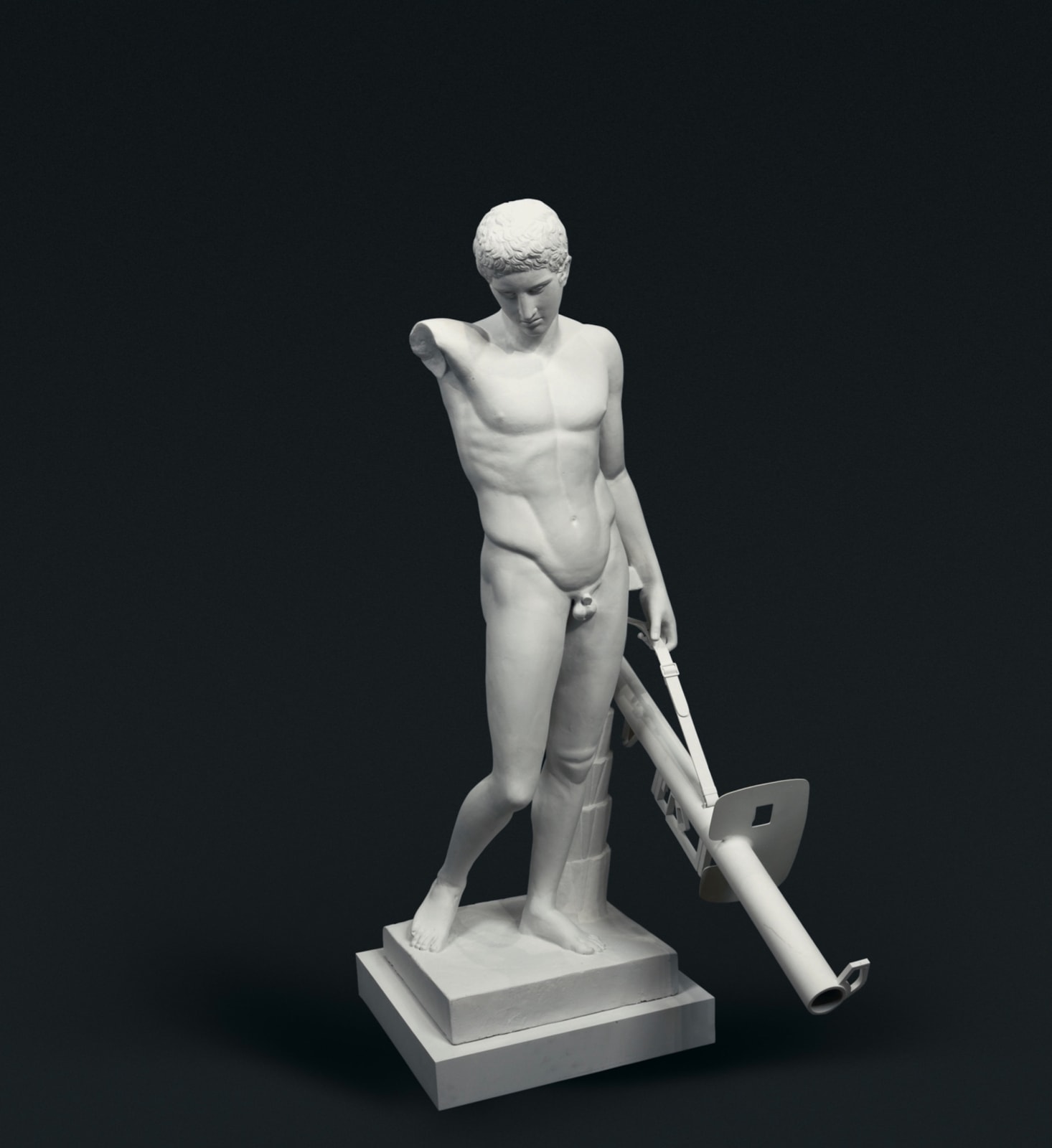-
Artworks


Ian Hamilton Finlay
Man With Panzerschreck, 1993plaster and metal61 x 17 3/8 x 19 1/4 in (155 x 44 x 49 cm)Man with Panzerschreck is a plaster replica, but for one critical addition, of a Classical Greek figural sculptural known as the “Ephebe Westmacott ” (ca. 440 BC.). Memorializing an Olympic...Man with Panzerschreck is a plaster replica, but for one critical addition, of a Classical Greek figural sculptural known as the “Ephebe Westmacott ” (ca. 440 BC.). Memorializing an Olympic athlete – or an artist’s envisioning of such – the Greek sculpture would have carried in its left hand a javelin or spear that Finlay, arrestingly, disconcertingly, has replaced with a WWII anti-tank rocket-launching rifle (“panzerschreck”). The Athlete/Man, his absent right arm raised in the act of crowning himself, probably with a laurel wreath, is supported from behind by the trunk of a palm tree, the palm being a symbolic device conventionally used in Classical sculpture to indicate a victor. In the context of Finlay’s art, the substitution – seemingly simple yet aggressively unorthodox – of a 20th-Century military weapon for the antique competitive one instantly transforms the athlete, a beautifully idealized young man, into the divine Apollo as a modern warrior. This substitution not only effects the apotheosis of an athlete, long-dead, into a vitally immediate as well as omnipotent god but also recasts the space he occupies into a Ideality – an Ideality suddenly, to us, shockingly present. The Classical Apollo – the god of archery, poetry, music, and the “sun,” in all the sun’s symbolic meanings – is vigorously restored to our age through the new-found attribute of a war gun, a gun of late model and most destructive (i.e., re-creative) force.
Yet Man with Panzerschreck is a Finlay Apollo with a difference, trailing his mortal origins. The “athlete’s” head is tilted downward; his weapon seems heavy, is slung low and at rest; although the laurel crown (Apollo’s crown) is assured, the competition is over, the race run; and the sculpture in which the young man and his victory are commemorated has been marred by time and will remain now forever incomplete, broken. Man with Panzerschreck can appropriately be thought of as an Arcadian Apollo, though not the typical Finlay-an Arcadian Apollo, his powers – his ideal purchase on “truth” and “beauty” – largely intact under camouflage wrap. Here, instead, we behold a humanized Apollo (Man) plaintively acquainted with death, with the eclipse of his powers, the passage of his beauty and the imperfection of his martial instruments. He is, in part, a figure of melancholy all the more achingly acute for his form’s native gracefulness: the embodiment of our deep “homesickness” for a lost (mythical) Golden Age.Exhibitions
Wars, David Nolan Gallery, New York, September 12 - November 9, 2019
Ian Hamilton Finlay: Camouflage, David Nolan Gallery, New York (November 4 – December 4, 2009)
MAILING LIST SIGN-UP
By completing this form, you confirm that you would like to subscribe to DAVID NOLAN’s mailing list and receive information about exhibitions and upcoming events. Your email address will be used exclusively for the mailing list service.
* denotes required fields
We will process the personal data you have supplied to communicate with you in accordance with our Privacy Policy. You can unsubscribe or change your preferences at any time by clicking the link in our emails.




